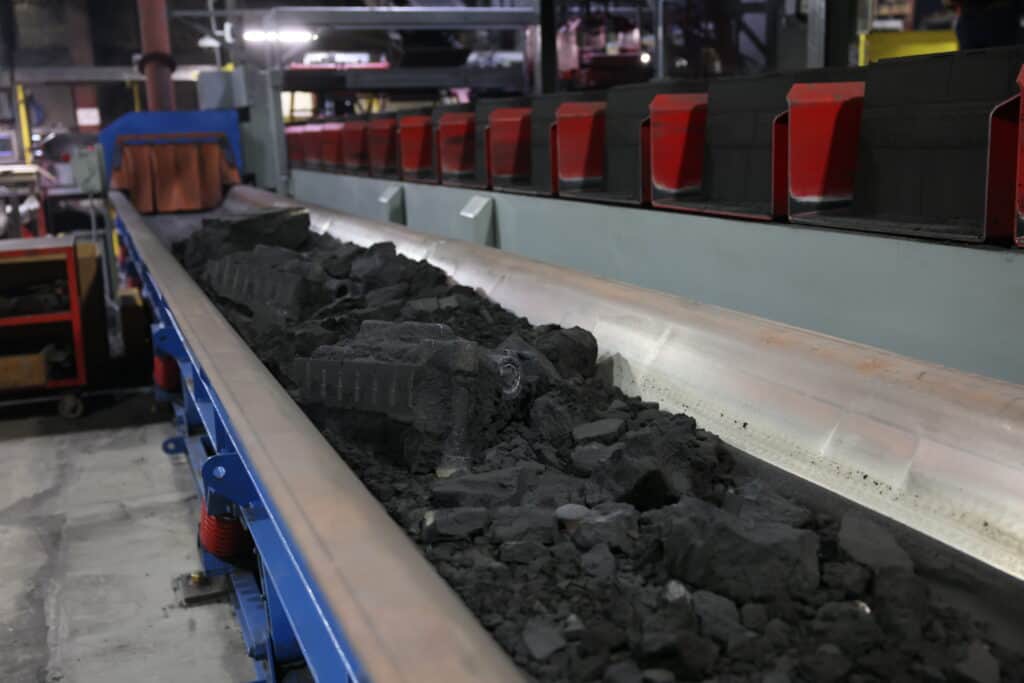What is Green Sand Casting?
Green sand casting is a type of casting that foundries employ using molds made from wet sand. Despite the name, it is not green or made from green sandstone. Green sand casting is named after “green wood,” a type of wood with moisture inside- like green sand.
Green sand casting is the most popular method of casting. It creates about 42% of metal castings, beating the second most used, no-bake casting, at 40%. Green sand casting is popular because of its efficiency and affordability. It can be used in several applications, such as automotive parts casting, electronic parts, gears, cookware, and more.
How is Green Sand Made?
Green sand is a mixture made up of a few key components:
- Silica, chromite, or zircon sand ~80%
- ~10% bentonite clay; works as a binder
- ~2-5% water
- ~5% sea coal
Sand is the main component of the sand mixture, typically amounting to 75-85% of the formula. The type of sand used varies depending on what kind of metal is used, price constraints, and desired physical properties. For example, different types of sands offer differences in casting finish, metal penetration, and thermal properties. Many iron foundries typically use silica sand. The rest of the mixture comprises of various amounts of water, sea coal, and bentonite clay. Bentonite clay and water combine to act as a bonding agent that holds the sand molds together to keep them from crumbling. This process is known as green sand molding.
How are Green Sand Molds Made?
Green sand is loaded into a flask or mold chamber, depending on the type of molding style. The sand is then compacted or squeezed against the patterns to create void space. This void space in the mold is filled with molten metal (such as aluminum or steel) to form the shape of the end product. The metal is then left in the mold to cool. Once it is thoroughly cooled, the shaped metal is removed from the mold. Read about the sand casting process in more depth here.
Depending on the equipment used, the mold components are typically reused or recycled for future castings. For example, the GK VIBRA-DRUM® is integral in reconditioning and even cooling casting sand.
Advantages of Green Sand Casting
Reusable
Sand used to create molds can be reused. This makes it cost-effective in the long term and helps with sustainability, as the sand isn’t simply thrown out.
Versatile / Efficient
Green sand casting is extremely versatile and can be used in a variety of processes, from manual bench molding to high-production automatic molding. Many of the components can be recycled and reused with the proper components that make up an effective foundry system.
Cost-efficient
It is reusable and saves you money on production materials. In addition, the process is simple compared to other casting types and has cost-effective machinery options.
Automation-friendly
Modern foundry technology makes casting automation more accessible than ever before. Green sand casting is no exception, with machinery like the SPIRA-COOL® or VIBRA-DRUM® making the cooling process automatic.
Disadvantages of Green Sand Casting
Defects are Common
This casting method is prone to defects, such as air holes, sand holes, shrinkage, and sand residue.
Casting Damage During Shakeouts
Castings may be damaged during the shakeout process when using outdated or ineffective equipment.
Low Dimensional Accuracy
Because sand is moldable, sand castings will be less accurate on high-detail models.
Low Strength
Sand molds aren’t as strong as other mold types, making them more prone to breakage and damage during pourings.
Revolutionize Green Sand Casting with GK Foundry Systems
Want to maximize your metalcasting efficiency while mitigating long-term costs and damage? GK Foundry Systems specializes in creating foundry systems that maximize your ROI and keep your downtime to a minimum. To optimize your foundry, contact a GK Foundry Systems expert today, and we’ll help you achieve your green sand casting goals.
